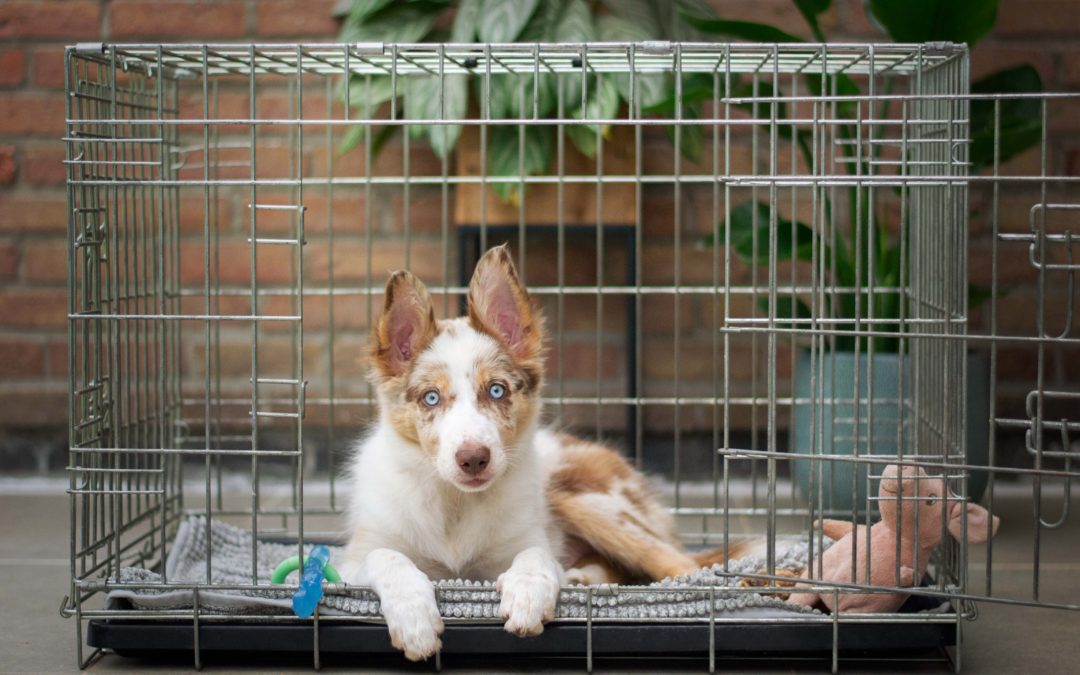Crate training
Crate training is a great tool to teach your puppy independence, bladder control, to keep them safe and rested, and to make future travel and vet visits easier. The crate should become one of their favorite places to hang out, so make sure you never use the crate as punishment. Select a crate that is just big enough for your puppy to stand up and turn around in. If the crate is too big, your puppy might use one end of the crate for a bedroom and the other end of the crate for a bathroom.
Keep the crate near your bed for at least the first week. This will help ease the transition from sleeping with their littermates to sleeping alone. Puppies need around 15-20 hours of sleep a day. Work toward having at least one long nap in the crate, as well as overnight sleep.
The first few times your dog goes into the crate, you can lure them in with kibble or treats. Close the door for just a few seconds, then open the door and give them another reward while they’re still in the crate. If they’re barking or pawing at the crate, wait for them to stop before you open the door. Release them from the crate with a word like “free” or “break.” Play this game for 3-5 minutes at a time, slowly building up the duration of crate time. It may take a few days before your puppy is comfortable spending extended periods in the crate with the door closed.
In addition to crate games, you should feed all of your pup’s meals and special treats like bully sticks and stuffed kongs in the crate with the door closed to create more positive associations. You can also leave “surprise treats” in the crate for your dog to find on their own.
When your puppy is ready to spend a longer stretch in the crate, wait until they are naturally tired before you put them in. Make sure the room that the crate is in is quiet and relaxing. If the puppy whines for 5-10 minutes and then stops, that’s okay. If they are whining any longer than that, take them out and go back to your crate games to slowly build up the amount of time that they can spend in the crate. If your dog whines after 30-60 minutes, they likely need to go to the bathroom. Let them out when they are quiet and don’t have their paws on the door.
Your dog should sleep in the crate until they are at least 10-12 months old. It’s a good idea to keep them used to the crate for their entire lives in case you need to travel with your dog, your dog has a medical procedure, or they just need a quiet place to call their own.
Potty training
Potty training or housebreaking are misleading terms because the puppy has very little to do with how well the process goes. It should be called “make sure your puppy’s bottom is where it needs to be at the right time,” but that’s not as catchy. Keep track of your puppy’s eating, drinking, and bathroom habits so you have an idea of how often they need to go. If you’re a modern dog owner, there are apps like Puppy Potty Log. Otherwise, pen and paper are just fine.
Depending on where you live, you may opt to start with pee pads, completely outside, or a combo platter. If the sidewalks near your home are a popular toilet for neighborhood dogs, wait until your pup is around 10-12 weeks old before they go to the bathroom outside without a pee pad. Even if you plan on keeping pee pads throughout your dog’s life, they should still learn that the grass or sidewalk is another place where they can go to the bathroom. Praise and reward your dog every time they go to the bathroom in the correct place.
“What do I do when my dog has an accident?” Clean it up – preferably with an enzymatic cleaner. If you scold your dog or rub their face in it, they will only learn that going to the bathroom in front of you is a scary thing. Refer back to your food, water, and bathroom log to try and figure out what happened. If your dog is training or running around with a friend, they will need more frequent bathroom breaks. They may also be drinking more water than usual during teething because of sore gums, so opt for frozen treats to give them relief. Another common reason for accidents is that the dog has too much freedom. Start with access to one or two rooms and keep them in a crate or pen when you can’t keep an eye on them. If they have gone two weeks with no accidents, you can introduce another room or half a room.
Most dogs are about 60-70% potty trained by 4 months of age and close to 90-100% trained by 6 months. One issue that can delay training is excitement or anxiety peeing. For excitement peeing, make sure they are “empty” before guests come over or the dog goes into a new place. Toss treats away from the fun thing for the first few minutes to refocus your pup. For anxiety peeing, try to keep their exposure to the scary thing at a level that they can handle. You may want to consult a certified trainer to work through issues like separation anxiety or sound sensitivity. If you notice any change in the frequency or appearance of their bathroom habits, consult your veterinarian.
Emily van den Blink is a CPDT-KA certified dog trainer in Jersey City and Manhattan. Contact emilyvandenblink@gmail.com or @vandendogs on Instagram for training questions and booking information.

